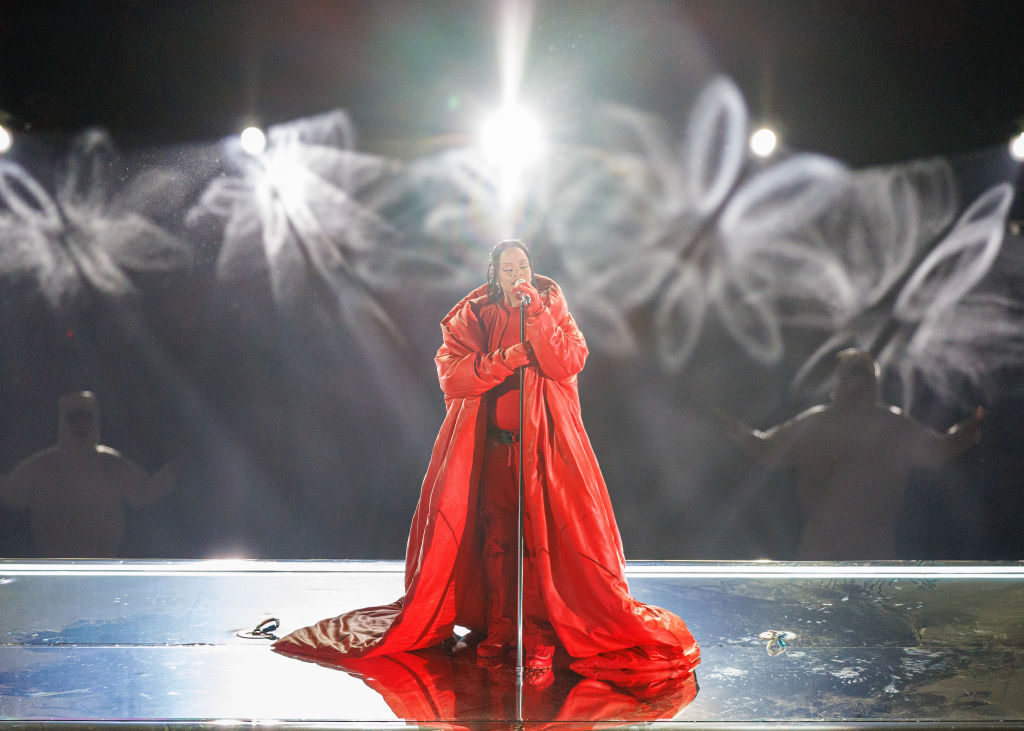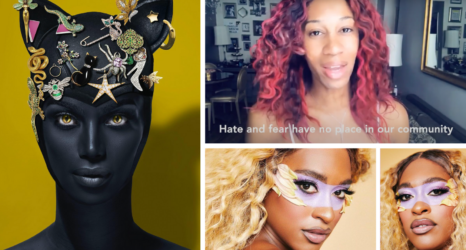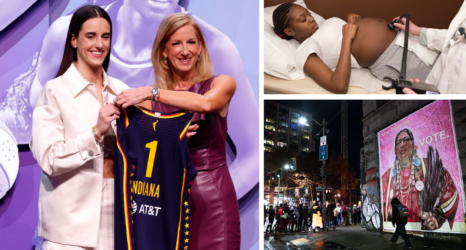Images of pregnant Black women finding their power on the world’s largest stages symbolize surviving and thriving in a racist and misogynistic system.

Even before pop star Rihanna’s highly anticipated halftime show at this year’s Super Bowl, Apple Music—the show’s sponsor—established her global reach through some provocative ads. There was a humorous assemblage of various NFL fans across races and genders attempting to sing her ballad “Stay.” Another ad spotlights New York’s Chinatown jeweler Chiok Va Sam, more popularly known in hip-hop circles as “A$AP Eva,” crafting Rihanna’s diamond-crusted insignia to her hit song “Diamonds.”
Perhaps most poignantly, Rihanna taps into her island roots as a young Black girl in Barbados, in schoolgirl uniform, snatches some cool sunglasses from a family member styling the edges of another Black woman on the steps of a verandah as they talk in the local patois about the pop star’s comeback.
The young girl struts on a neighborhood road while she is approvingly greeted by her community and joined by some other young girls—all neatly put together in fabulously braided hairstyles. We later see this road is now named “Rihanna Drive,” the same spot where a young Robyn Rihanna Fenty flew kites over a cemetery before she had big dreams that she would “Run This Town.”
Taken together, these ads remind us of a woman who is at once global and local. She makes connections with many around the world while staying true to who she really is: just a regular Black girl on a Caribbean island with some big dreams.
She positioned her body to evoke both superstar status and regular womanhood.
Rihanna’s pop star persona has always maintained this edge of “regular woman” meets “island girl” realness. With a catalog of 14 number one hits and a beauty and fashion business that has transformed her into a billionaire (the first woman music artist to achieve this status), Rihanna is certainly more “exceptional” than she often lets on—but her success model is predicated on this connection to the ordinary.
Who could forget how she rocked the cosmetics industry with her 40-plus foundation shades in Fenty Beauty that covered the entire range of women’s complexions, a vision that decidedly came from the radical interventions by a woman of color. She later put Victoria’s Secret to shame when she brought the same inclusive vision and body-positive energy to her lingerie brand Savage X Fenty.
During her 13-minute halftime show, Rihanna made sure to pause to put on some of this foundation, a proud self-promotion of her beauty enterprise, but more importantly, she positioned her body to evoke both superstar status and regular womanhood. After a seven-year hiatus from music, and having given birth to a son back in May, the audience did a double-take: Is Rihanna pregnant … again? Her publicist confirmed her condition after her performance.
Not that this stopped audiences from criticizing the show as low-energy or underwhelming. I myself had drawn this conclusion in my first impression, but repeat viewings revealed so many subversive moments of a pop star becoming the first pregnant person to perform at the Super Bowl. This is quite the feat.
First, there is the reveal of the baby bump itself. As the show summons the pop star with a quick riff of her hit song “What’s My Name,” set against Rihanna’s silhouette illuminated by computer-generated star dust, the camera closes in on her face, which boldly stares into the crowd, a playful smirk announcing her presence before she sings into the mic while her free hand literally moves over the curve of her belly before resting on her crotch area.
It’s a pop-star Michael Jackson move: When men make this gesture, they summon power and masculine energy. Rihanna does the same and especially through the power of her reproducing body.
There are other gestures that hold poignant memories and subversions. Some have noted how her red baggy overcoat summons the Black fashion icon André Leon Talley, a friend of Rihanna’s and Vogue editor who died last year. Not only does this fashion choice pay homage, it also pointedly demonstrates how Rihanna might have easily camouflaged her pregnancy from our collective gaze, but she chose not to.
Just like her bare belly exposed underneath a winter coat during her first pregnancy, Rihanna deliberately announces her expectancy and does so through the transparent yet covered red lining that outlines the curves of her body. Equally telling is the red breastplate revealed beneath her overcoat. It echoes the black breastplate that Janet Jackson had worn during her own infamous halftime show, before it was abruptly ripped off by Justin Timberlake and then led to the “wardrobe malfunction” scandal. Here, Rihanna alludes to the red bodice that was supposed to have provided cover for Janet Jackson’s nipple, instead boldly revealing how she can both play to and shield the dominant white cultural gaze from her body. Here, she is powerfully in command.
Indeed, as with Beyoncé’s halftime show, Rihanna is surrounded by a large collective of background dancers—highly feminine for the former star, while androgynous in white puffers for the latter star—a reminder that their star personas are powerfully protected by a supportive community, choreographically, socially, culturally and politically. And, just as Prince—with his own halftime show—combined his musical and sexual prowess through his silhouette that extended the “phallic” energy of his guitar onto his own body, so too does Rihanna extend the sexually provocative lyrics and choreography in her songs “Rude Boy,” “Wild Thoughts” and “Pour It Up” through her suggested posturing and limited dance moves (surely toned down due to her condition!).
These Black performers creatively illuminated sex-positive energy within a stage surrounded by football violence, “purity” aspirations for Americana culture, and a muted diversity that can only welcome Black entertainment without its full power unleashing before millions of watchers. All these aspects shape Rihanna’s overall performance, which muted some of her sexuality while making space for her embodied star power that relied not just on background dancers but the technical wizardry of floating stages that gave the impression of Rihanna literally levitating in the air.
It is no mere coincidence that Rihanna subversively begins her set with her controversial “Bitch Better Have My Money,” a song and video that holds to account the ways that white heteronormative forces attempt exploitation of Black female talent. This holds even more value when performed during Black History Month and during a time when Caribbean nations—including her home island Barbados—have been pushing for slavery reparations. Not to mention the problematic ways that the NFL does not pay these performers who bring in additional viewers to the game. Rihanna makes this command as her stage descends from the air in a move suggesting the literally grounded importance of materiality. However, for her finale, she ascends once more, this time singing about how she can now “shine bright like a diamond.”
Black performers creatively illuminated sex-positive energy within a stage surrounded by football violence, “purity” aspirations for Americana culture, and a muted diversity that can only welcome Black entertainment without its full power unleashing before millions of watchers.
I must admit I got a little teary-eyed when she once again cradled her baby bump while singing, “When you hold me, I’m alive, we’re like diamonds in the sky / I knew we’d become one right away,” the music temporarily changing to an orchestral rendition. It was a poignant moment of transcendence, both musically and physically.
Her performance of ordinary Black pregnant womanhood certainly “zagged” to the “zig” of Beyoncé’s equally powerful performance as a Black pregnant woman who invoked the multiple modalities of goddess imagery during her Grammy appearance in 2017. Rihanna went less for goddess and more for the regular woman who is floating on an air of contentment and bliss, but the message is the same: See how divine and powerful I am.
Such images are especially powerful against the backdrop of disturbing stories of Black women still experiencing higher maternal death rates—regardless of wealth and income—and of states like Mississippi (the same state that helped to overturn Roe v. Wade with the Dobbs v. Jackson Women’s Health Organization Supreme Court decision last year) now experiencing a 900 percent increase in congenital syphilis among newborns (many of whom are born to Black women).
The realities of how Black pregnant people are devalued in our healthcare system need to be countered with hope and aspiration. These images of pregnant Black women finding their power and their support on some of the largest global stages are a powerful contrast—and protest.
Perhaps this is why so many women of color bristle against criticisms of these highly visible performances, knowing what is at stake for the rest of us. Rihanna’s various subversions of this national stage must be acknowledged and celebrated in the wake of these realities. We rejoice at the simple magic of a Black woman being herself and resonating across the spectrums of humanity.
Surviving and thriving against a racist and misogynistic system is almost divine. And Rihanna, who once revealed she lives by biblical words, as instructed by the grandmother named for her Clara Lionel Foundation charity that funds hospitals, COVID vaccines and educational opportunities, offers a different model for how billionaires can give back to their communities: not by simply pouring in money in Super Bowl ads and dictating that “He Gets Us,” but by doing and acting in ways that suggest that she gets him.
Rihanna of course also gets us, which is why we—like her background dancers, fans and global community—will always have her back.
Up next:
U.S. democracy is at a dangerous inflection point—from the demise of abortion rights, to a lack of pay equity and parental leave, to skyrocketing maternal mortality, and attacks on trans health. Left unchecked, these crises will lead to wider gaps in political participation and representation. For 50 years, Ms. has been forging feminist journalism—reporting, rebelling and truth-telling from the front-lines, championing the Equal Rights Amendment, and centering the stories of those most impacted. With all that’s at stake for equality, we are redoubling our commitment for the next 50 years. In turn, we need your help, Support Ms. today with a donation—any amount that is meaningful to you. For as little as $5 each month, you’ll receive the print magazine along with our e-newsletters, action alerts, and invitations to Ms. Studios events and podcasts. We are grateful for your loyalty and ferocity.





